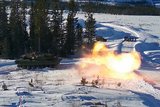Lockheed’s MHTK in new test firing
Lockheed Martin's Miniature Hit-to-Kill (MHTK) missile has been tested at White Sands Missile Range, New Mexico, to demonstrate the interceptor’s increased agility, the company announced on 30 January.
The test also validated the performance of MHTK’s airframe and updated electronics, which are now common between the missile's two configurations: active and semi-active seeker.
The missile's increased agility enhances the interceptor’s ability to defeat rocket, artillery and mortar targets with greater accuracy, reliability and range.
The MHTK interceptor is less than 2.5ft in length and it weighs about 5lbs at launch. It uses hit-to-kill technology, which destroys threats through an accurate application of kinetic energy in body-to-body contact. Hit-to-kill technology eliminates the incoming threat while reducing the risk of collateral damage seen in traditional blast-fragmentation interceptors.
Tim Cahill, vice president of Integrated Air and Missile Defense at Lockheed Martin Missiles and Fire Control, said: ‘The design of the MHTK interceptor enables a highly effective solution in a very compact package. This test is exciting because it is another successful milestone demonstrating the interceptor's revolutionary capabilities. We look forward to building on this success.’
More from Land Warfare
-
Germany signs multi-billion-dollar deals for 6x6 CAVS and GDELS Eagle vehicles
The order is a further boost for the Common Armoured Vehicles System programme which has notched notable successes in the past 12 months. The first vehicle, made in Finland, will be delivered next year with local production expected to ramp up in 2027.
-
![Rheinmetall and KNDS tank tie-up narrows trans-European options]()
Rheinmetall and KNDS tank tie-up narrows trans-European options
The French and German governments signed an agreement in June 2018 to cooperate on the development of a new main battle tank under the Main Ground Combat System programme but the effort has struggled. This new agreement may damage it further.
-
![Hungary set to begin using Hero 400 loitering munitions]()
Hungary set to begin using Hero 400 loitering munitions
Developed by Israel's Uvision and with systems being sold in the thousands to multiple European NATO countries and the US, the Hero family of loitering systems is also in production in the US and Italy, the latter through Rheinmetall.
-
![Light Reconnaissance Strike – enabling a vital mission set (Studio)]()
Light Reconnaissance Strike – enabling a vital mission set (Studio)
A new system-of-systems concept will unlock digital integration of sensors and weapons for Light Forces, allowing them to shape the battlefield environment on their own terms and upgrade legacy platforms.

























